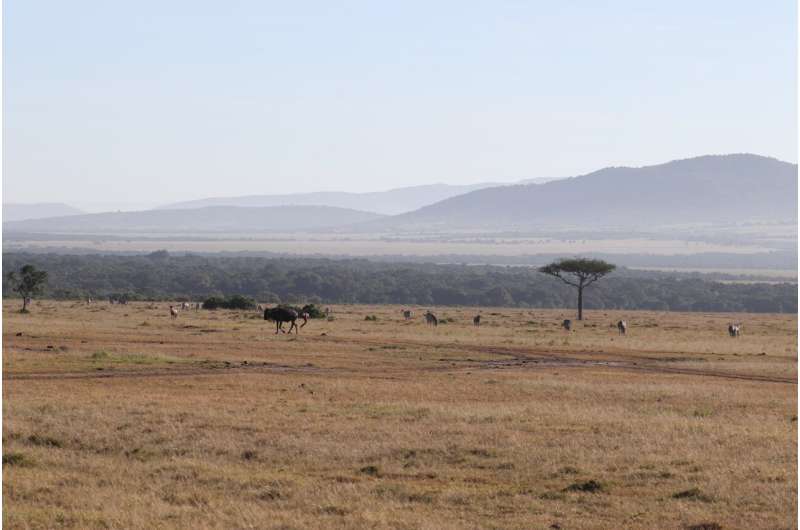This article has been reviewed according to Science X's editorial process and policies. Editors have highlighted the following attributes while ensuring the content's credibility:
fact-checked
trusted source
proofread
Research finds climate change and increasing population put Kenya at risk of famine

Research published in Outlook on Agriculture has shown that the population relative to available climate-suitable areas in Kenya has increased, posing a threat to the country's economy and food security.
The study, "Spatial changes to climate suitability and availability of agropastoral farming systems across Kenya (1980-2020)," was published online on May 29.
The research team analyzed Kenya's farming systems and climate zones between 1980–2020. Over that time, the population of Kenya more than tripled while climate-suitable areas for primary crops decreased.
Increased dryness and higher temperatures are reducing productivity in agriculture and the increase in human population is limiting space for livestock productivity. In East Africa, climate change impacts agricultural suitability because rain-fed agriculture accounts for upwards of 95% of crop production.
"The climate crisis compromises food and water security, while threatening farmers' livelihoods. This study quantified climate change-induced cropland shrinkage, which is particularly alarming with the human population growing exponentially," said Enbal Shacham, Ph.D., professor of behavioral science and health education at Saint Louis University's College for Public Health and Social Justice and acting director of strategic initiatives for the Taylor Geospatial Institute. "This research highlights these urgent problems in Kenya and in other agricultural regions across the world."
The first author is Ted J. Lawrence, a former Taylor Geospatial Institute post-doctoral fellow. Shacham is the paper's senior author.
The research team looked at how trends changed over time and how the geographic distribution and arrangement of climate zones in Kenya shifted due to those trends. The team focused on Kenya because rain-fed agriculture is central to the country's economy and it is a key food-producing country for the East African region.
Primary crops grown in the region include maize, wheat, rice, tea, coffee, sugarcane, sisal and cotton. Dairy farming makes up a large portion of livestock production.
The research found that climate change is a major threat to Kenyan farming systems with seasonal changes in precipitation and temperature. Those changes are leading farmers to look for new farming and animal husbandry techniques.
Climate-suitable areas over the study period decreased. Those decreases included a 13% decrease in ranching; a 21% decrease in dairying; a 24% decrease in mixed crops and a 28% decrease in mixed crops and dairying.
The research team created climate reference maps and assessed temperature zones and precipitation patterns within each zone.
The researchers reviewed data from a variety of sources, including:
- Georeferenced average monthly temperature and precipitation across Kenya with a 5-kilometer resolution during 1976–1980, 1996–2000 and 2016–2020 from the TerraClimate dataset;
- A digitized version of the georeferenced boundaries of the Kenyan ACZs documented in 1982 and obtained through the IGAD Climate Prediction and Application Center Portal;
- Georeferenced boundaries of counties in Kenya, circa 1980, 2000 and 2020;
- Temperature, precipitation and ACZ requirements for crops, dairying, ranching and pastoralism from Kenya's ministry of Agriculture; and
- Kenyan county-level agricultural and population censuses from 1980, 2000 and 2020.
Agro-climate suitability shifted across Kenya throughout the study period, with climates suitable areas for all primary crops decreasing 28% between 1980 and 2020. Rice saw the largest decrease (-54%), followed by sugarcane, (-43%), tea (-37%), sisal (-34%), wheat (-29%), maize (-28%) and Arabica coffee (-4%). Areas suitable for Robusta coffee increased by 6% and areas good for growing cotton increased by 30%.
Agro-pastoral areas in Kenya are under increasing pressure from climate change, the research team found, and that may impact food and livelihood security, health and well-being, and the overall ecosystem. Climate change, along with a rising population, creates a risk of famine.
Information on climate change and population growth in this paper can be used to help develop policy and aid in the effort to reach the United Nations' Sustainable Development Goals.
More information: Ted J Lawrence et al, Spatial changes to climatic suitability and availability of agropastoral farming systems across Kenya (1980–2020), Outlook on Agriculture (2023). DOI: 10.1177/00307270231176577
Provided by Saint Louis University


















